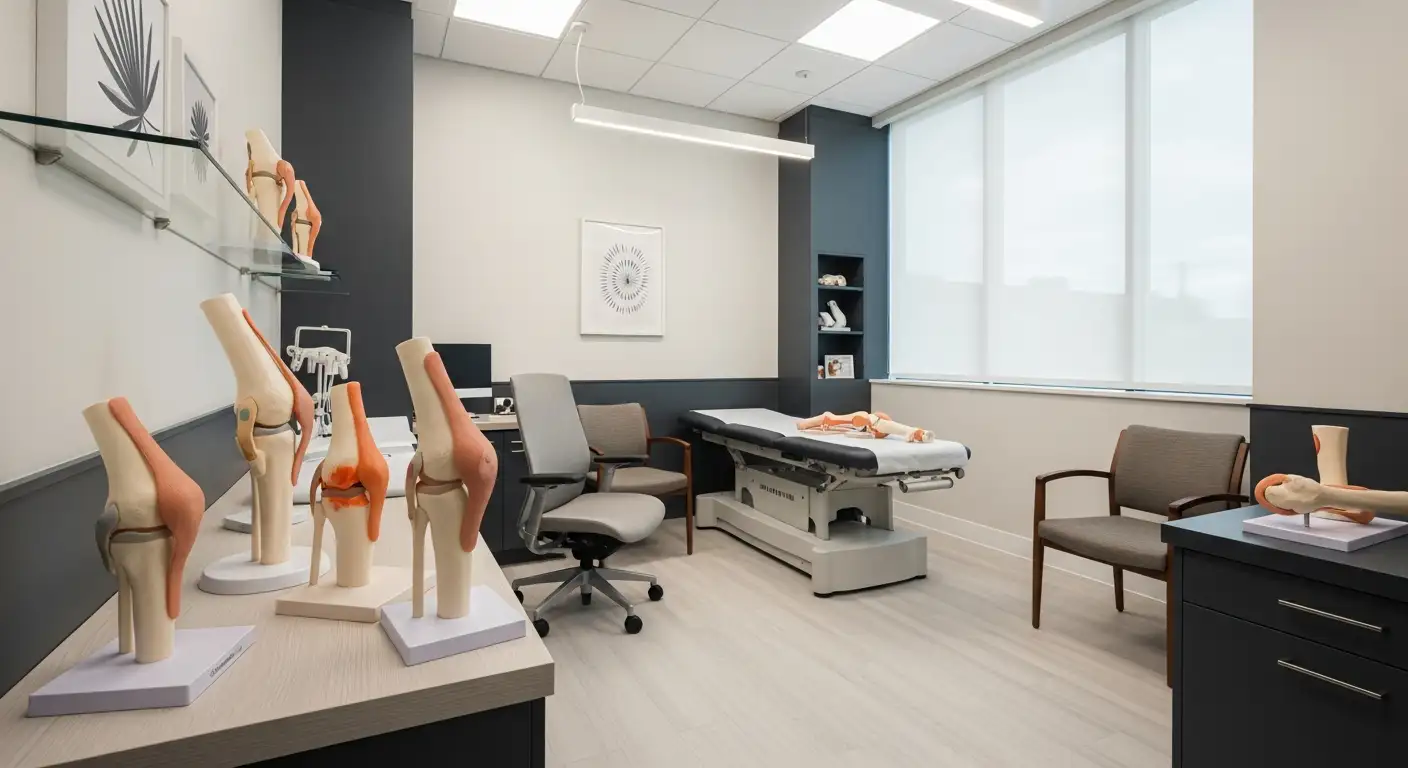Deciphering Knee Pain: A Guide to Acute and Chronic Conditions
Knee pain is a common complaint that can stem from a variety of causes, ranging from sudden injuries to long-term degenerative conditions. Differentiating between acute and chronic knee pain is crucial for appropriate treatment and effective management. This article explores the key characteristics, causes, diagnostic methods, and treatment approaches for both types, equipping you with the knowledge to recognize and respond to knee pain appropriately.
Defining Acute vs. Chronic Knee Pain

Duration and Onset of Pain
The primary difference between acute and chronic knee pain lies in how long the pain lasts and how it begins. Acute knee pain occurs suddenly, often immediately following an injury such as a sports accident, fall, or trauma. It is usually sharp and intense, lasting less than six weeks. In contrast, chronic knee pain develops gradually over time, persisting for more than three months. It often lacks an immediate injury and can be continuous or episodic.
Pattern of Symptoms
The pattern of symptoms helps distinguish between the two types of pain. Acute pain is intense, sudden, and often accompanied by swelling, redness, or difficulty moving the knee. It generally subsides as the underlying injury heals. Chronic pain, however, tends to be dull, aching, and persistent. It may worsen with activity or at the end of the day, and often includes ongoing stiffness and swelling.
Underlying Causes
Underlying reasons for knee pain also vary. Acute pain is commonly caused by injuries like ligament tears (such as ACL injuries), meniscal tears, fractures, or dislocates. Chronic pain often results from degenerative conditions like osteoarthritis, rheumatoid arthritis, or long-standing tendinitis. Infections, bursitis, or previous injuries that did not heal properly can also lead to persistent joint pain.
How can I tell if my knee pain is acute or chronic?
To determine whether knee pain is acute or chronic, assess when it started and how long it has lasted. If the pain began suddenly after an injury and lasts less than six weeks, it is likely acute. If the pain has persisted beyond three months, or if it develops gradually without a specific injury, it is likely chronic. Recognizing these differences helps guide diagnosis and treatment options.
Understanding these distinctions aids in seeking the appropriate medical care, whether it involves urgent interventions for acute injuries or ongoing management for chronic conditions.
Characteristics and Symptoms of Each Type

What are the characteristic symptoms of acute versus chronic knee pain?
Acute knee pain appears suddenly and is usually caused by injury or trauma. It is marked by a sharp, intense sensation of pain that often comes with swelling, redness, and difficulty in moving the knee. This type of pain typically develops rapidly after an incident such as a ligament tear, fracture, or bump and usually lasts a few days to weeks. The symptoms are often specific to the injury, making it easier to link the pain to a particular event.
On the other hand, chronic knee pain develops gradually over months or even years and is often linked to degenerative conditions like osteoarthritis or rheumatoid arthritis. It presents as a dull, aching discomfort that may fluctuate in intensity. People with chronic knee pain might experience stiffness, a sense of instability, or a feeling of discomfort that persists even when the injury has healed. Unlike acute pain, chronic pain can be accompanied by emotional and physical effects such as muscle tension, fatigue, or mood changes, impacting overall quality of life.
While acute pain acts as a warning sign prompting immediate attention, chronic pain often requires ongoing management and medical treatment. Recognizing the differences in symptoms can help in timely diagnosis and appropriate intervention, focusing either on acute injury care or long-term strategies for degenerative or systemic causes.
Common Causes of Acute and Chronic Knee Pain

What are the common causes of acute and chronic knee pain?
Knee pain can originate from various sources, and understanding the difference between causes of acute and chronic pain helps guide diagnosis and treatment.
Trauma and injury are primary causes of sudden, or acute, knee pain. Common traumatic reasons include ligament tears like ACL injuries, meniscus tears, dislocations, and fractures resulting from falls, sports accidents, or direct impacts. These injuries often cause sharp, localized pain, swelling, and difficulty moving the joint.
On the other hand, degenerative conditions frequently cause long-lasting or chronic knee pain. Osteoarthritis is the most common; it involves the gradual breakdown of cartilage, leading to joint pain, stiffness, and reduced mobility. Rheumatoid arthritis, an autoimmune disease, can also cause persistent inflammation and pain.
Inflammatory and overuse issues contribute significantly to both acute and chronic discomfort. Overusing the knee during activities like running, jumping, cycling, or heavy labor can cause tendinitis, bursitis, and runner’s knee, which often result in dull, aching pain that worsens with activity.
Obesity is a major factor for long-term joint strain, increasing the likelihood of degenerative cartilage damage and sustained pain. Other causes include gout, infections, and, rarely, tumors.
In summary, trauma often causes sudden pain due to injury, while degenerative and inflammatory conditions tend to produce ongoing pain that worsens over time if untreated. Both types are influenced by lifestyle, age, and overall health, making accurate diagnosis crucial.
| Cause Type | Examples | Description |
|---|---|---|
| Traumatic Injuries | ACL tears, fractures, dislocations | Sudden injuries from accidents, sports, falls |
| Degenerative Conditions | Osteoarthritis, rheumatoid arthritis | Wear and tear or autoimmune processes causing joint damage |
| Overuse and Inflammation | Tendinitis, bursitis, runner’s knee | Repetitive movements leading to irritation and pain |
Recognizing these causes helps determine the appropriate course of treatment and management for knee pain.
Diagnostic Methods to Differentiate the Types

How is knee pain diagnosed to determine whether it is acute or chronic?
Diagnosing whether knee pain is acute or chronic involves several steps that help healthcare professionals identify the underlying cause and the severity of the condition.
Initially, a thorough medical history assessment is conducted. The doctor will ask about the onset of pain, duration, intensity, and any triggering events or injuries. For acute pain, symptoms often follow a specific injury or trauma, such as a sports injury, fall, or accident. Chronic pain, on the other hand, tends to develop gradually and persists for more than six months, often related to degenerative conditions like osteoarthritis.
Next, a physical examination is performed to evaluate the knee's swelling, redness, warmth, stability, range of motion, and areas of tenderness. Specific tests, such as lachman or anterior drawer tests, can assess ligament integrity, while palpation can identify points of tenderness or swelling. For acute injuries, signs like swelling, instability, or deformity suggest ligament tears, fractures, or meniscal injuries. Chronic conditions might show signs like joint stiffness, crepitus, or decreased mobility.
Imaging studies are crucial for an accurate diagnosis. X-rays are commonly used to detect fractures, joint space narrowing, or bone spurs typical of osteoarthritis. MRI scans provide detailed images of soft tissues such as ligaments, menisci, and cartilage, helping detect tears, inflammation, or degenerative changes. Ultrasound may also be employed to visualize soft tissue injuries and fluid accumulation.
Laboratory tests, including blood work, can identify inflammatory or systemic conditions like rheumatoid arthritis or gout that may cause persistent pain. Elevated markers of inflammation or specific crystals in joint fluid can guide diagnosis.
By combining the patient's history, physical exam findings, imaging results, and lab tests, clinicians can differentiate between acute injuries—such as ligament tears or fractures—and chronic conditions, like osteoarthritis or tendinitis. This comprehensive approach ensures targeted treatment, whether it involves rest and physical therapy for minor injuries or surgical intervention for severe damage.
This methodical evaluation is essential for developing an effective treatment plan and improving patient outcomes.
More about diagnosing various causes of knee pain:
Searching for
When to Seek Medical Attention
Signs of severe injury or infection
If you experience sudden, severe pain with swelling, deformity, or inability to move the knee, it is crucial to seek immediate medical care. These signs may indicate a serious injury such as a fracture, dislocation, or ligament tear. Additionally, symptoms like redness, warmth, and significant tenderness could signal an infection, which requires prompt treatment.
Persistent or worsening pain
While acute knee pain often subsides within days, pain that persists beyond this period or worsens over time should be evaluated by a healthcare professional. Chronic pain lasting more than several months, or worsening daily, may indicate underlying conditions like osteoarthritis or ongoing inflammation that need targeted management.
Associated systemic symptoms
Be alert for signs of systemic illness, such as fever, chills, or excessive fatigue, which can accompany infections or inflammatory diseases. The presence of these symptoms alongside knee pain necessitates urgent evaluation.
When should I seek medical attention based on its nature?
You should consult a doctor if your knee pain is severe, sudden, or progressively worsening, especially if accompanied by swelling, redness, warmth, or tenderness. Immediate attention is needed if you experience inability to bear weight, instability, or deformity after injury. Signs of infection, such as fever or redness, also warrant prompt medical care.
Additional considerations
Even if pain is minor, ongoing discomfort that interferes with daily activities or sleep should be investigated. Early diagnosis helps manage the cause effectively and avoid complications. Remember, trusting your instincts and seeking prompt care ensures the best outcomes for knee health.
Treatment Strategies for Both Types
Initial and acute management
When dealing with acute knee pain, the primary focus is on stabilizing the injury and reducing inflammation. The RICE method—rest, ice, compression, and elevation—is the cornerstone of initial treatment. Over-the-counter pain relievers like NSAIDs or acetaminophen are often recommended to manage pain and swelling. In some cases, immobilization with braces may be necessary to prevent further damage.
For severe injuries, such as ligament tears or fractures, prompt medical evaluation is critical. Imaging tests like X-rays or MRI scans help confirm the diagnosis. Immediate treatment may involve surgical intervention, especially if there are significant structural damages.
Long-term and chronic management
Chronic knee pain, which lasts longer than three to six months, requires a different approach focused on long-term care. Physical therapy plays a vital role in strengthening the muscles around the knee, increasing flexibility, and improving joint stability. Lifestyle modifications, such as maintaining a healthy weight, engaging in low-impact activities like walking or yoga, and avoiding excessive stress on the joint, help slow progression.
Injection therapies, including corticosteroid injections or viscosupplementation, can provide temporary relief from persistent symptoms. For cases where conservative treatment fails, more invasive procedures like surgery may be considered.
Surgical and non-surgical options
Non-surgical methods include physical therapy, medications, braces, and injections, all aimed at reducing pain and improving joint function. These options are typically preferred initially, especially in mild to moderate cases.
When structural damage is severe or conservative therapies do not yield relief, surgical options such as knee arthroscopy, repair of torn ligaments or meniscus, or total knee replacement may be necessary. Surgery is generally considered a last resort and is reserved for cases with significant joint degeneration or mechanical dysfunction.
Overall, treatment plans are individualized based on the specific cause, severity, and patient health status. Early diagnosis and appropriate management are crucial for effective recovery and preventing long-term disability.
Empowering You with Knowledge
Differentiating between acute and chronic knee pain is essential for seeking appropriate treatment and avoiding complications. Understanding the distinct features, causes, diagnostics, and management options for each pain type enables patients to make informed decisions about their healthcare. Whether your pain is sudden or persistent, early intervention can improve outcomes and restore knee function, ensuring an active and healthy lifestyle. Consulting with healthcare professionals is recommended for persistent or severe symptoms to determine the underlying cause and tailored treatment plan.
References
- Acute Knee Pain and Chronic Knee Pain: There's a Difference
- Understanding the Differences Between Acute and Chronic Knee Pain
- Knee pain - Symptoms and causes - Mayo Clinic
- Knee Pain in Adults and Adolescents: The Initial Evaluation | AAFP
- Acute Pain vs. Chronic Pain: Differences & Causes - Cleveland Clinic
- How To Differentiate Between Acute and Chronic Joint Pain
- Knee Pain Conditions, Causes, Symptoms, Treatments - HSS
- Types of Knee Pain: Acute vs Chronic, How to Identify Them
- Knee Pain - Causes & Treatment | Made for This Moment
- Chronic Knee Pain Causes and Treatment - OIP





